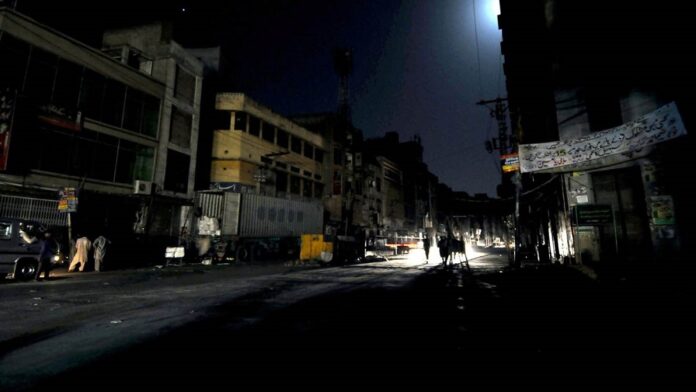ISLAMABAD: On Monday, a catastrophic failure in the national grid caused the worst electrical outage in months across the country, crippling life and spotlighting the country’s ageing energy infrastructure. Profit has obtained a report of the National Transmissions and Despatch Company detailing how the blackout played out.
The report, published on the 24th January explains the blackout. The company has conceded that the system protection mechanism in place did not prevent the cascade impact of tripping, which plunged the entire country into darkness on January 23.
Authorities began restoring electricity to millions of people late on the same night while an investigation was launched to determine the reasons for the outage. The blackout lasted more than 12 hours in the majority of the regions, while in some areas it lasted even longer.
The basics
When you turn on an appliance, such as your kettle or laptop charger, it is powered by alternating current. This indicates that the electricity alternates between positive and negative voltage. This back-and-forth motion, or “oscillation,” is referred to as electrical frequency.
Grid frequency, measured in Hertz (Hz), is a technical term that refers to the number of times the alternation cycle occurs every second. Currently, 50 Hz is the most prevalent frequency used in the bulk of the world’s power systems, including Pakistan’s.
Because the equipment in your house, factory, or office is designed to run at 50 Hz within a narrow tolerance, maintaining the frequency of our power supply is critical. This is the reason why everyone turns their appliances off when there’s a fluctuation in the voltage or frequency of electricity. If this isn’t done there’s a possibility of equipment and appliances being damaged.
The issue is that frequency can be difficult to control; if the exact amount of electricity needed is not matched by generation, the frequency of the electricity on the grid can be affected.
What happened?
The report reads that, “system frequency [had] gone up to 50.75 hertz (Hz) and severe hunting was observed… that caused load and voltage variation on transmission lines. As a result… transmission lines tripped which resulted in isolation of [the] North and South system followed by blocking of [the] HVDC (High Voltage Direct Current) system”.
According to the initial statements by the minister of energy Khurram Datagir and the ministry, the system experienced a “loss of frequency that caused a major breakdown”. This seems to be inconsistent with the report of NTDC that categorically states that the frequency had gone up.
n an interview, the minister of energy Khurram Dastagir explained what happened. “In winter, the demand for electricity reduces nationwide, hence, as an economic measure, we temporarily close down our power generation systems at night.”
But when the power plants were restarted on the morning of January 23, “frequency variation and voltage fluctuation,” were discovered in southern Pakistan, “somewhere between Dadu and Jamshoro,” he said. Consequently, this led to the “power generating units to shut down one by one.”
This is wholly inconsistent with what the report of the NTDC states, fundamentally if there is more demand for electricity than supply, for example, frequency will reduce. When there is an excess of supply, frequency rises.
Now if we were to go by this understanding then the system tripped because there was an excess supply of electricity, and the claims of the minister that a “loss” of frequency caused the system to trip are incorrect.
The report also breaks down the scale of the blackout, right prior to the incident the total generation stood at 11,356 megawatts(MW) and a frequency of 50.31 Hz. At the time of the incident 23rd January at exactly 7:34 am the frequency spiked to 50.57 Hz. This caused a chain reaction in which large 500 kv supply power cables tripped.
The thing to point out here is the fact the frequency was operating on a higher level prior to the spike on the morning of the black out. This should’ve initially served as a warning to the regulators that supply exceeded the demand causing a rise in the frequency.
The exact occurrence that caused this hike in frequency is still unknown, this is simply due to the fact that anything could have occurred at any location on the grid. It can be caused by severe weather, human error, equipment failure, or even animal interference.
Bottom line this spike triggered the power plants safety mechanisms that shut down all of the 23 power plants supplying power to the grid.
To put it simply the entire grid works on the fundamental principle of circuit breakers. An electrical circuit breaker is a switching mechanism that can be operated manually or automatically to control and protect the electrical power system and the electrical devices that are linked to it.
When there is too much electricity flowing through the circuit breaker, it trips, or it cannot handle the excess current load. This means that the flow of power is interrupted to prevent overheating or further damage to your circuits.
Now apply the same principle on the national grid. Power plants are built to run within a specific frequency range, the same as a circuit breaker; if there’s a higher frequency in the system, there is a risk of them disconnecting from the grid after a particular amount of time or suddenly depending upon the location of the fault.
How did they get the power back?
If the entire national high voltage electricity network — the grid — loses power, individual power stations must be restarted before they can power the country.
To operate, power plants often require an electrical supply similar to how a car needs a battery to power the ignition. However, with a total power outage, there is no centrally-connected electricity available at scale to restart the system. As a result, it must be restarted from scratch.
This process is known as “Black start”. Black Start’s operation is actually quite straightforward. Smaller power sources start larger ones, and so on until the entire country is powered up again.
Some power plants simply do not have the ability to be the starting point of this complex reboot.
But some modern gas power plants are able to restart rapidly on demand. In the case of Pakistan the restoration of the southern region began from the “UCH-I” power plant in district Nasirabad, Balochistan.
This gas powered plant is owned by the Uch Power Limited company, having a capacity of 586 MW. The interesting fact about this plant is that it has a “black start facility up to 220 kv” according to the NTDC report. The importance of this power plant cannot be understated.
Simultaneously for the northern region, the restoration process began from Tarbela, Warsak and Mangla.This is simply due to the fact that hydropower possesses all of the properties that make it excellent for black start.
Reservoirs hold enough water to power turbines during a black start operation with no special preparation. According to an Oak Ridge National Laboratory study, hydro facilities may be restarted fast with minimal station power.
Although the report highlights that, “the generating units at Tarbela and Mangla couldn’t maintain stability and tripped a number of times during the restoration process”. Consequently, generating from Warsak was extended to the other dams initiating the reboot.
This essentially marked the start of the restoration as electricity from these power plants was sent to other plants so that they could reboot and resume operations.
According to the report the restoration process began with the Uch power plant in Balochistan at 9:39 am on Monday morning. And the grid was completely restored with the final power plant to be restarted at 4:57 am the next morning.
Interesting observations
Although NTDC or the government have not yet established the exact reason causing the power black out and it is impossible to determine it at this point. However, as per some observers the first domino that initiated the blackout was the 747 MW gas power plant located in Guddu, Sindh.
The initial issues in the transmission network were observed in three 500kv heavy power lines connected to the power plant in question. Additionally the same power plant was the last to be restored at 4:57 am the next morning.
























Recording success in Cryptocurrency.. Bitcoin is not just buying and holding till when bitcoin sky-rocks this has been longed abolished by intelligent traders mostly now that bitcoin bull is still controlling the market after successfully defended the $20,000 support level once again and this is likely to trigger a possible move towards $40,000 resistance area However it is best advice you find a working strategy by hub/daily signals that works well in other to accumulate and grow a very strong portfolio ahead. I have been trading with Mr Mark Toray’s daily signals and strategy on his platform and his guidance makes trading less stressful and more profitable despite the recent fluctuations I was able to easily increase my portfolio in just 3weeks of trading with his daily signals growing my 0.9 BTC to 2.9BTC. Mr Toray’s daily signals are very accurate and yields a great positive return on investment. I really enjoy trading with him and I’m still trading with him He is available to give assistance to anyone who love crypto trading and beginners in bitcoin investment I would suggest you contact him through mail marktoray8@gmail. com or telegram @mark4toray bitcoin is taking over the world
Monday Blackout is very exclusive informative article in this post explained very well